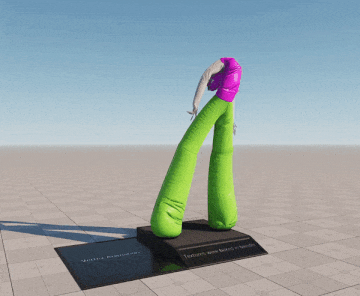Vertex Animation Sample

This material graph sample demonstrates how to use a vertex animation texture in UNIGINE.
Vertex animation can be baked into a texture via one of the modern DCC tools (the example contains textures baked in Blender) and then exported as a set of several files: a geometry file (.fbx) and texture files: textures for the model and textures storing animation (an .exr texture with position offsets and a .tga texture with normals). Then these files are imported into UNIGINE to create the material graph.
The textures with animation are imported with the following settings:
| Position offsets texture | Normals texture |
|---|---|
|
|
Albedo and Roughness data for the Vertex Animation material are sampled via the Sample Texture node from the provided albedo and shading textures with accordance to the specified UVs (the Vertex UV 0 node). The Roughness data is also multiplied by a roughness coefficient after sampling.
Object-space Normal data for the material is obtained by blending of tangent-space normals sampled via the Sample Texture node from the provided normal and animation normal textures and subsequent transforming the output tangent-space normals to the object-space ones (the Rotate Space node).
At that, when sampling of the animation normal texture is performed, the original UV is modified as follows: the U coordinate is provided by the Vertex UV 1 node, the V coordinate is the time multiplied by the animation speed. After sampling, vertex interpolation is performed (the Vertex Interpolation node).
Vertex Position data for the material is sampled via the Sample Texture node from the provided position offsets texture according to the UV that is modified as follows: the U coordinate is provided by the Vertex UV 1 node, the V coordinate is the time multiplied by the animation speed. After sampling, the data is multiplied by the vertex offset intensity and then added to the Vertex Position.
